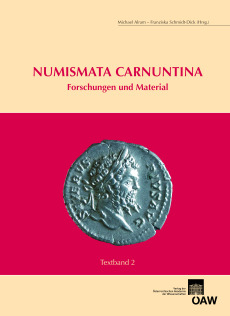Numismata Carnuntina
Forschungen und Material
Herausgegeben von Franziska Schmidt-Dick, Herausgegeben von Michael Alram
Reihe: Denkschriften der philosophisch-historischen KlasseCarnuntum ist seit mehreren hundert Jahren als einer der bedeutendsten Fundorte römischer Münzen in Europa bekannt und hat in dieser Hinsicht auch immer wieder das Interesse der numismatischen Forschung auf sich gezogen. In einem über zehn Jahre dauernden Großprojekt wurden durch die Numismatische Kommission fast 40.000 im Museum Carnuntinum in Bad Deutsch-Altenburg befindliche Carnuntiner Fundmünzen erfasst und einer numismatisch-historischen Auswertung unterzogen, deren abschließende Ergebnisse hier vorgelegt werden. Neben dem Münzkatalog, der auf CD-ROM erscheint, werden in elf Beiträgen die wichtigsten Forschungsfragen zu den Fundmünzen von Carnuntum beleuchtet. Ein Kernstück der Publikation bildet die statistische Auswertung des Gesamtmaterials. Ebenso wird das Schatzfundaufkommen der gesamten Region einer Analyse unterzogen und in diesem Zusammenhang die Frage des sogenannten „Markomannenhorizonts“ neu aufgerollt. Ein weiteres Kapitel ist der Geschichte und Münzprägung des Carnuntiner Kaiserpaares Regalianus und Dryantilla gewidmet. Ein besonderes Charakteristikum Carnuntums und des mittleren Donauraums sind die sogenannten Limesfalsa und Eisenmünzen, die erstmals einer substantiellen Analyse unterzogen werden. Ergänzende Beiträge beschäftigen sich unter anderem mit dem vorrömischen Geldumlauf, den in der Kaiserzeit umlaufenden Münzen der Republik, dem Zustrom von Fremdgeld und der nachrömischen Geldgeschichte Carnuntums.

